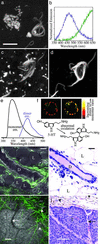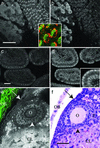Live tissue intrinsic emission microscopy using multiphoton-excited native fluorescence and second harmonic generation
- PMID: 12756303
- PMCID: PMC165832
- DOI: 10.1073/pnas.0832308100
Live tissue intrinsic emission microscopy using multiphoton-excited native fluorescence and second harmonic generation
Abstract
Multicolor nonlinear microscopy of living tissue using two- and three-photon-excited intrinsic fluorescence combined with second harmonic generation by supermolecular structures produces images with the resolution and detail of standard histology without the use of exogenous stains. Imaging of intrinsic indicators within tissue, such as nicotinamide adenine dinucleotide, retinol, indoleamines, and collagen provides crucial information for physiology and pathology. The efficient application of multiphoton microscopy to intrinsic imaging requires knowledge of the nonlinear optical properties of specific cell and tissue components. Here we compile and demonstrate applications involving a range of intrinsic molecules and molecular assemblies that enable direct visualization of tissue morphology, cell metabolism, and disease states such as Alzheimer's disease and cancer.
Figures




References
-
- Denk, W., Strickler, J. H. & Webb, W. W. (1990) Science 248, 73-76. - PubMed
-
- Williams, R. M., Zipfel, W. R. & Webb, W. W. (2001) Curr. Opin. Chem. Biol. 5, 603-608. - PubMed
-
- Freund, I. & Deutsch, M. (1986) Opt. Lett. 11, 94-96. - PubMed
-
- Fine, S. & Hansen, W. P. (1971) Appl. Opt. 10, 2350-2553. - PubMed
Publication types
MeSH terms
Substances
Grants and funding
LinkOut - more resources
Full Text Sources
Other Literature Sources

